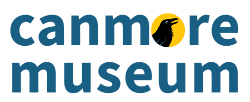Known as Chuwapchipchiyan Kudi Bi by the Stoney Nakoda, Canmore is defined by the rugged Canadian Rocky Mountain landscape that surrounds us and shaped by the culture, language and traditions of those that have called this place home for over 10,000 years. Located in the heart of our charming and historic downtown, the Canmore Museum and the NWMP Barracks Provincial Historic Site’s collections, programs and exhibitions provide numerous opportunities to explore and experience our mountain landscapes, culture and community.
Land Acknowledgement
Canmore and all of the Bow Valley is located on the traditional lands of Indigenous Peoples as referred to in the United Nations Declaration on the Rights of Indigenous Peoples. This relationship to the land is further declared by the National Indian Brotherhood (now Assembly of First Nations), in A Declaration of The First Nations (1981). Historically, there is a long-standing connection to the Bow Valley around Canmore for many Indigenous nations – Stoney Nakoda, Blackfoot, Tsuut’ina, Ktunaxa, Secwépemc, Dene, Mountain Cree, and Métis.
We acknowledge that we are on territory known as Treaty 7, which is a treaty signed on behalf of Queen Victoria in 1877, with the Stoney Nakoda (Bearspaw, Chiniki, and Goodstoney), Blackfoot Confederacy (Kainai, Piikani, and Siksika), and Tsuut’ina Nations.
Our Promise
By 2024, the Canmore Museum will be a space where diverse voices are heard, where connections with one another and the landscapes around us can be made, and the long-term sustainability of our local community and the natural environment that is our home is at the fore front of every decision we make. Whether Canmore has been your home for five minutes, five generations or five millennia, we promise that your story will be reflected throughout the museum’s public spaces and exhibitions, in our collections, and in our programming. We will encourage your active participation in creating meaningful experiences where personal, cultural and societal topics can be discussed without fear or prejudice
Our Purpose
The purpose statement succinctly set forth the organization’s long-range aspirations, within a focused framework of plans and programs
As a community museum re-imagined for the 21st century, the purpose of the Canmore Museum is to build community, build a shared understanding of place, to build community memory, and to build a lasting legacy of community, environmental and organizational sustainability.
Our Vision
While a mission describes the museum’s current state, the vision sets out the future direction. At its core, the vision is an aspirational and inspirational statement that provides direction for the entire organization.
We deliver compelling and remarkable experiences which celebrate community, place, and culture.
A New Mission
Our new mission statement moves beyond Canmore’s coal mining history. While mining will always be an essential part of Canmore’s story, there is so much more to tell. Whether it is arts, culture, adventure or our community’s intimate relationship with the Rocky Mountains, our new mission seeks to bring these stories to life.
Our mission is to ignite shared experiences and unexpected connections. To do this, we find, spark, preserve, and trade stories, ideas, and elements of creativity drawn from people in Canmore and the Bow Valley. We bring people together around art, history, place and culture to build a stronger, more connected community.
Our Values
We aim to be:
Collaborative | We work with the community to shape what we collect and interpret as well as to reach new audiences. Our collective impact is far greater than what we can achieve alone.
Educational | We provide enriching inquiry-based, curriculum-related programs that connect students to the history and geoscience of their environment. We encourage teachers, students, and visitors to explore new vistas of our mountain culture through engaging educational experiences.
Engaging | We believe that the museum is a place of learning, scholarship, contemplation, conservation, and curation. Programming is the heart of everything we do to engage our audiences.
Inclusive | We believe the museum is a safe, accessible, and inclusive public space that values and seeks diverse opinions and experiences on issues related to the environment, social justice, and human rights. The museum acts as a mirror for the community and allows for deep retrospection, meaningful debate, and action on community issues.
Remarkable | We strive to create a museum experience that can be felt and not passively observed. This includes offering digital experiences as well as physical, human connection with great historians, geoscientists, and storytellers.
Sustainable | Social, environment, and community needs are identified and in alignment with the museum’s direction, programming, and outreach activities.
Our History
Connecting our community with its culture, history, and landscape for over 37 years, this is our story …
Since its humble beginnings in the early 1980s, the Canmore Museum has established itself as a community organization valued for its contributions to Canmore’s cultural and social life. We welcome over 25,000 visitors a year into our two facilities, and our school and community programs allow us to annually work with nearly two thousand students and families in our community. Each summer, visitors and locals look for our Roving Scientist interpreters on Canmore trails or to join one of our many adventure experiences. We also offer walking tours of historic sites easily accessible from the Museum and host numerous events throughout the year.
The stories we tell as part of these experiences are backed by a rich collection of artifacts, photographs, records and maps which have been donated by the community and held in the public trust, a responsibility we do not take lightly.
